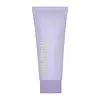What's inside
What's inside
 Key Ingredients
Key Ingredients

 Benefits
Benefits

 Concerns
Concerns

 Ingredients Side-by-side
Ingredients Side-by-side

Water
Skin ConditioningGlycerin
HumectantPotassium Cocoyl Glycinate
Disodium Laureth Sulfosuccinate
CleansingLauryl Hydroxysultaine
CleansingPotassium Cocoate
EmulsifyingAcrylates/C10-30 Alkyl Acrylate Crosspolymer
Emulsion Stabilising1,2-Hexanediol
Skin ConditioningTromethamine
BufferingDipropylene Glycol
HumectantSodium Chloride
MaskingLimonene
PerfumingHydroxyacetophenone
AntioxidantCaprylyl Glycol
EmollientLactobacillus/Rye Flour Ferment
Skin ConditioningLactobacillus/Soymilk Ferment Filtrate
Skin ConditioningBacillus/Soybean Ferment Extract
Skin ConditioningPropanediol
SolventCitrus Nobilis Peel Oil
MaskingDisodium EDTA
Citrus Aurantium Dulcis Peel Oil
MaskingCitrus Aurantium Bergamia Fruit Oil
MaskingSodium Hyaluronate
HumectantDipotassium Glycyrrhizate
HumectantRaspberry Ketone
MaskingEthylhexylglycerin
Skin ConditioningMentha Arvensis Leaf Oil
MaskingNiacinamide
SmoothingFolic Acid
Skin ConditioningPantothenic Acid
Skin ConditioningPyridoxine
Skin ConditioningThiamine Hcl
MaskingCyanocobalamin
Skin ConditioningRiboflavin
Cosmetic ColorantWater, Glycerin, Potassium Cocoyl Glycinate, Disodium Laureth Sulfosuccinate, Lauryl Hydroxysultaine, Potassium Cocoate, Acrylates/C10-30 Alkyl Acrylate Crosspolymer, 1,2-Hexanediol, Tromethamine, Dipropylene Glycol, Sodium Chloride, Limonene, Hydroxyacetophenone, Caprylyl Glycol, Lactobacillus/Rye Flour Ferment, Lactobacillus/Soymilk Ferment Filtrate, Bacillus/Soybean Ferment Extract, Propanediol, Citrus Nobilis Peel Oil, Disodium EDTA, Citrus Aurantium Dulcis Peel Oil, Citrus Aurantium Bergamia Fruit Oil, Sodium Hyaluronate, Dipotassium Glycyrrhizate, Raspberry Ketone, Ethylhexylglycerin, Mentha Arvensis Leaf Oil, Niacinamide, Folic Acid, Pantothenic Acid, Pyridoxine, Thiamine Hcl, Cyanocobalamin, Riboflavin
Centella Asiatica Leaf Water 69%
Skin ConditioningWater
Skin ConditioningDisodium Cocoamphodiacetate
Cleansing1,2-Hexanediol
Skin ConditioningSodium Chloride
MaskingTea-Cocoyl Glutamate
CleansingHexylene Glycol
EmulsifyingCitric Acid
BufferingPolyglyceryl-4 Caprate
EmulsifyingPentylene Glycol
Skin ConditioningButylene Glycol
HumectantCaprylyl Glycol
EmollientTrehalose
HumectantAllantoin
Skin ConditioningGlycerin
HumectantMelaleuca Alternifolia Leaf Water
AntimicrobialOryza Sativa Bran Extract
Skin ConditioningPortulaca Oleracea Extract
Skin ConditioningPerilla Frutescens Leaf Extract
MaskingAspalathus Linearis Extract
Skin ConditioningCommiphora Myrrha Resin Extract
Skin ConditioningGlycyrrhiza Glabra Root Extract
BleachingEthylhexylglycerin
Skin ConditioningCentella Asiatica Leaf Water 69%, Water, Disodium Cocoamphodiacetate, 1,2-Hexanediol, Sodium Chloride, Tea-Cocoyl Glutamate, Hexylene Glycol, Citric Acid, Polyglyceryl-4 Caprate, Pentylene Glycol, Butylene Glycol, Caprylyl Glycol, Trehalose, Allantoin, Glycerin, Melaleuca Alternifolia Leaf Water, Oryza Sativa Bran Extract, Portulaca Oleracea Extract, Perilla Frutescens Leaf Extract, Aspalathus Linearis Extract, Commiphora Myrrha Resin Extract, Glycyrrhiza Glabra Root Extract, Ethylhexylglycerin
Ingredients Explained
These ingredients are found in both products.
Ingredients higher up in an ingredient list are typically present in a larger amount.
1,2-Hexanediol is a synthetic liquid and another multi-functional powerhouse.
It is a:
- Humectant, drawing moisture into the skin
- Emollient, helping to soften skin
- Solvent, dispersing and stabilizing formulas
- Preservative booster, enhancing the antimicrobial activity of other preservatives
Caprylyl Glycol is a humectant and emollient, meaning it attracts and preserves moisture.
It is a common ingredient in many products, especially those designed to hydrate skin. The primary benefits are retaining moisture, skin softening, and promoting a healthy skin barrier.
Though Caprylyl Glycol is an alcohol derived from fatty acids, it is not the kind that can dry out skin.
This ingredient is also used as a preservative to extend the life of products. It has slight antimicrobial properties.
Learn more about Caprylyl GlycolEthylhexylglycerin (we can't pronounce this either) is commonly used as a preservative and skin softener. It is derived from glyceryl.
You might see Ethylhexylglycerin often paired with other preservatives such as phenoxyethanol. Ethylhexylglycerin has been found to increase the effectiveness of these other preservatives.
Glycerin is already naturally found in your skin. It helps moisturize and protect your skin.
A study from 2016 found glycerin to be more effective as a humectant than AHAs and hyaluronic acid.
As a humectant, it helps the skin stay hydrated by pulling moisture to your skin. The low molecular weight of glycerin allows it to pull moisture into the deeper layers of your skin.
Hydrated skin improves your skin barrier; Your skin barrier helps protect against irritants and bacteria.
Glycerin has also been found to have antimicrobial and antiviral properties. Due to these properties, glycerin is often used in wound and burn treatments.
In cosmetics, glycerin is usually derived from plants such as soybean or palm. However, it can also be sourced from animals, such as tallow or animal fat.
This ingredient is organic, colorless, odorless, and non-toxic.
Glycerin is the name for this ingredient in American English. British English uses Glycerol/Glycerine.
Learn more about GlycerinChances are, you eat sodium chloride every day. Sodium Chloride is also known as table salt.
This ingredient has many purposes in skincare: thickener, emulsifier, and exfoliator.
You'll most likely find this ingredient in cleansers where it is used to create a gel-like texture. As an emulsifier, it also prevents ingredients from separating.
There is much debate on whether this ingredient is comedogenic. The short answer - comedogenic ratings don't tell the whole story. Learn more about comegodenic ratings here.
The concensus about this ingredient causing acne seems to be divided. Research is needed to understand if this ingredient does cause acne.
Scrubs may use salt as the primary exfoliating ingredient.
Learn more about Sodium ChlorideWater. It's the most common cosmetic ingredient of all. You'll usually see it at the top of ingredient lists, meaning that it makes up the largest part of the product.
So why is it so popular? Water most often acts as a solvent - this means that it helps dissolve other ingredients into the formulation.
You'll also recognize water as that liquid we all need to stay alive. If you see this, drink a glass of water. Stay hydrated!
Learn more about Water